
Whenever I am caught inside with a camera, I am usually wisely thrown out. My friend FNY correspondent Sergey Kadinsky doesn’t run into that kind of trouble and got inside the lobbies of several fantastical Sunnyside apartments, which are duly displayed this week.
By SERGEY KADINSKY
Forgotten NY correspondent
ONE of my favorite western Queens neighborhoods is Sunnyside. It hasn’t received the glass-and-steel makeover of Long Island City and seems a bit less gentrified than Astoria. Its architecture is a mix of six-storey prewar apartments, the landmarked Sunnyside Gardens townhouses, attached two-family homes, and recent infill units.
I was in Sunnyside recently to drop off a car at Major World, known to many New Yorkers for their loud radio ads. Its repair shop is an “island” surrounded by train tracks and connected to the neighborhood by a bridge. With the waiting room being renovated, I passed the time by strolling through Sunnyside.
Most of the streets in Sunnyside conform to the borough-wide grid. Kevin has been to the single-block Celtic Avenue and the lengthy Greenpoint Avenue, which predate the grid. Following the trend on Forgotten-NY, I’m devoting most of this essay towards the unique interior spaces and entrances of Sunnyside.
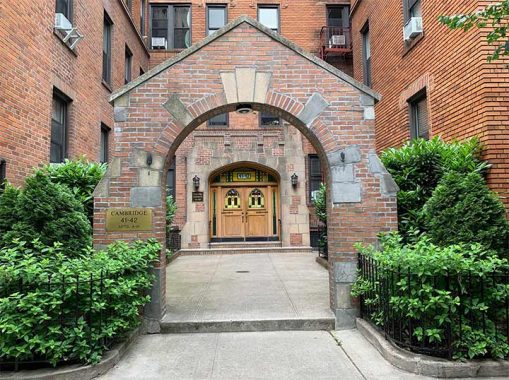
From a distance, the apartments appear similar but upon a closer look, many of them have entrances designed to welcome residents and give them a sense of history, appearing centuries older than their actual age. The Cambridge apartments at 41-42 42nd Street has a brick arch that leads to wooden doors with stained glass windows marking its address.
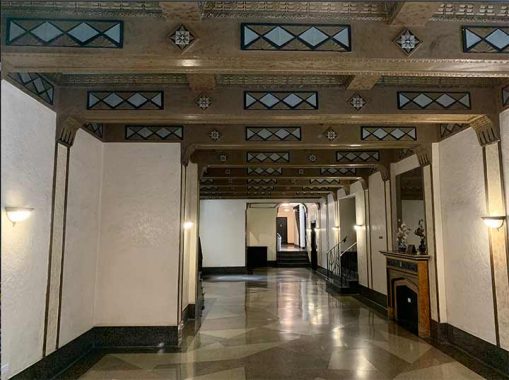
Inside the building is a lengthy lobby with random polygons on the stone floor, diamond patterns on the ceiling beams, and a display fireplace. With a couple of bookshelves and couches, this lobby could resemble a living room in a mansion.
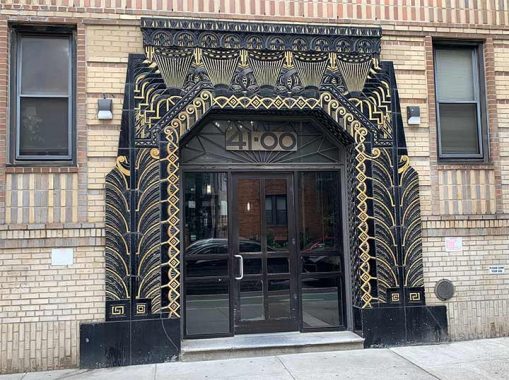
The hotspot for art deco apartments in New York is on the Grand Concourse in the Bronx. In Sunnyside the best example of this style is 41-00 43rd Avenue where the entrance is ringed by floral and geometric patterns. The wall around this entrance is composed of orange and yellow striped bricks. Our friend and former Sunnysider Heather Quinlan knows this building’s history in detail.
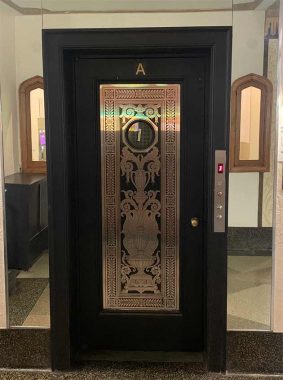
I took many photos on that day and do not remember the addresses for all of them, besides it is not my intention to invade the privacy of apartment lobbies. This elevator door has the gold color of an art deco illustration with classicist vessels inside the floral frame. Most elevator doors across the city slide to open on their own but older doors have a knob and require users to pull it open for access.
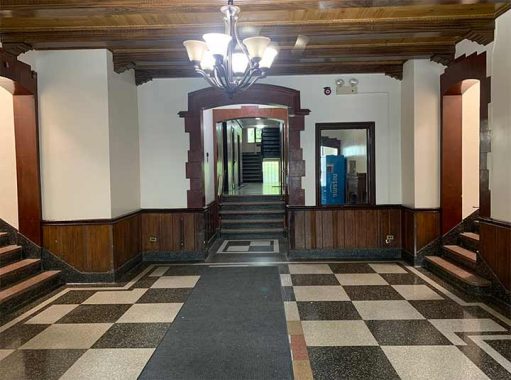
The lobby of this apartment building has a Tudoresque appearance evoking an old college hall. Wooden elements in a brick building give it the historic feel.
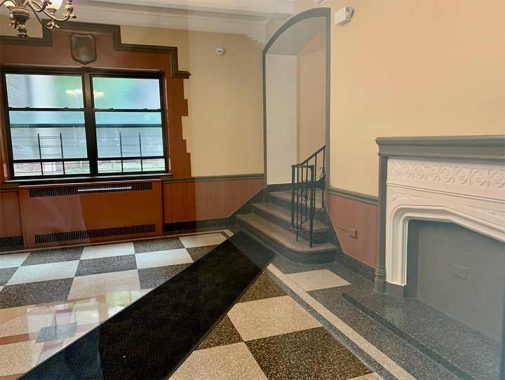
Dozens of lobbies across Sunnyside have fake fireplaces that serve as visual centerpieces. The electric outlets allow for an electric fire display, or more likely to light a Christmas tree and other holiday lights. Note the heraldic seal above the window. Likely it has no connection to any noble family, but you never know.
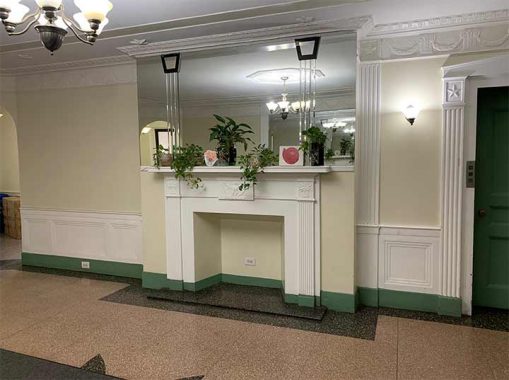
The mantel of this fake fireplace is decorated with fake plants. The white cornice here reminds me of mid-19th century mansions and plantations.
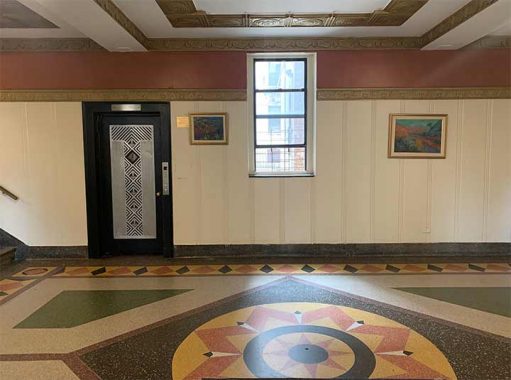
When you don’t see art deco on the brickwork, or the main entrance, the most common place to see it is on the lobby floor, where colorful geometry is laid out in a symmetrical manner. The design on the elevator door shares the style with the floor.
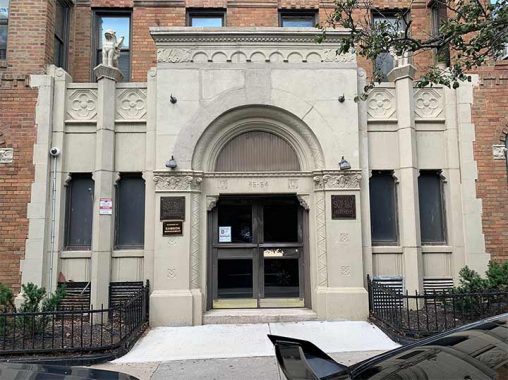
If this entire building were to be demolished in favor of a post-millennial glass tower, I hope that the entrance arch would be preserved. The Sun-Ray apartments at 41-54 41st Street have a Romanesque look with griffins standing above the entrance and quatrefoils.

Six windows on the slides of the main entrance have their own griffins to protect the residents and there are also two grotesques looking on on people entering and leaving. As a CCNY alum, I can share that a gargoyle represents an animal while a grotesque is the architectural term for a human caricature in stone. My campus has hundreds of them on its Gothic Revival buildings.
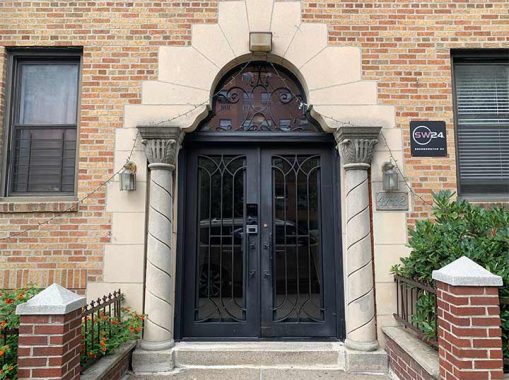
At 47-32 41st Street, the spiral columns evoke famous examples such as the altar at St. Peter’s Basilica and perhaps the first Holy Temple. The address number plate also has an interesting font.
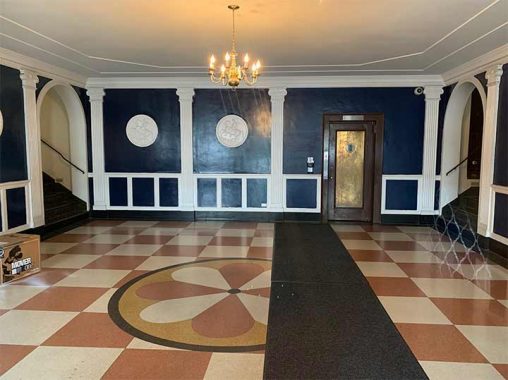
The exterior of 47-50 41st Street boasts the marquee Washington Towers. Perhaps decades ago it towered above its neighbors but not so much these days. It is the lobby that impressed me with roundels of a general on horseback and walls inspired by a colonial period design. The chandelier adds to the upscale historical appearance. Typically buildings with presidential names are intended to have a sense of importance.
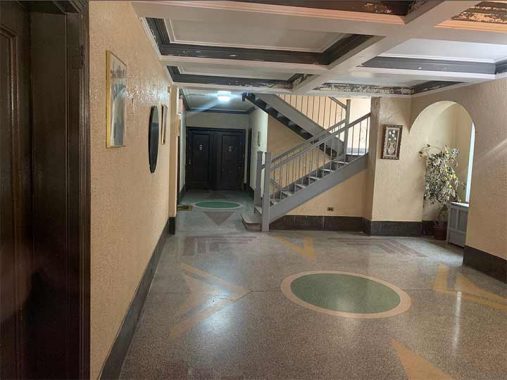
Across the street, the address 47-21 honors President Martin Van Buren, a native of the Hudson Valley. The art deco exterior has patterns of brick stripes and the lobby matches the style with its floor patterns.
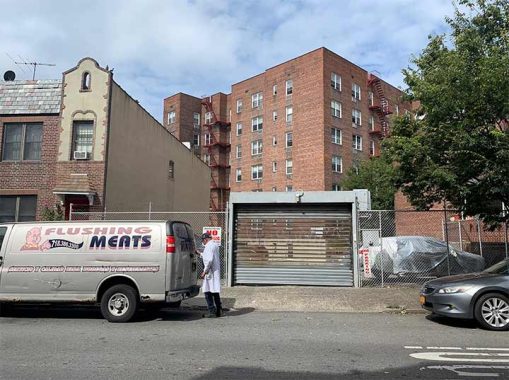
In 2020, Kevin traced all segments of Old Bowery Road, which includes Celtic Avenue and a triangular park at 43rd Street and 50th Avenue. But there is one more example that appears behind 47-37 45th Street. The front appears nondescript but its rear defied the grid, appearing diagonal to its neighbors. The property line behind this building matches the route of Old Bowery Road. A similar situation appears in Bensonhurst, where a phantom segment of Kings Highway separates backyards on a residential block.
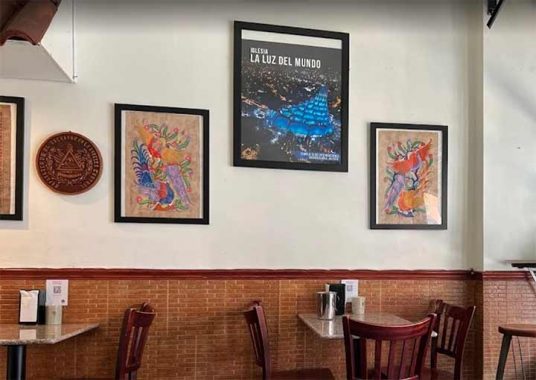
Nearby is Ricas Pupusas y Mas, a small eatery offering the signature Salvadoran dish that is made of cornmeal or rice, related to the arepa of Venezuela and Colombia. As the Salvadoran community grows in the metropolitan region, pupuserias are opening throughout Queens and Long Island.
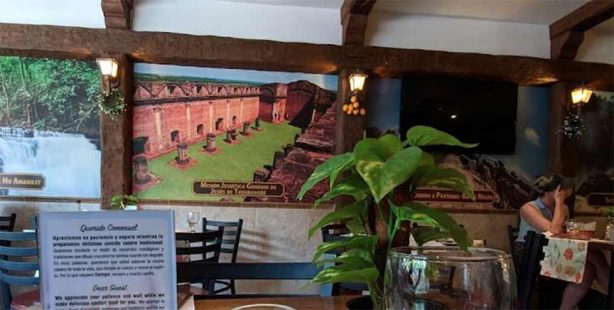
With Dominicans, Puerto Ricans, and Colombians as the city’s largest Latin American communities, smaller groups such as the Salvadorans do their best to highlight their countries and cultures. I Love Paraguay on Greenpoint Avenue has posters of famous sights in this landlocked South American nation. Sunnyside also has a couple of Romanian restaurants and a Romanian Orthodox church. Their language is related to Spanish, but their country and religion are Eastern European. My Moldovan-born grandfather spoke Romanian and had an easy time watching Spanish soccer matches.
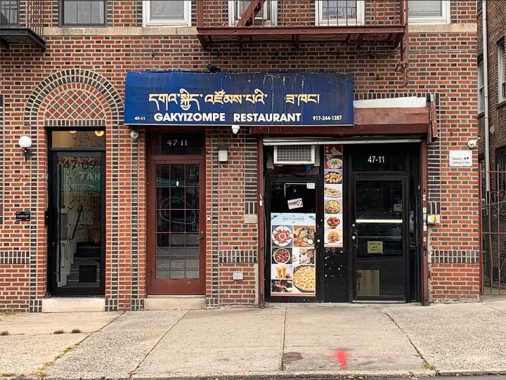
Within Elmhurst, Jackson Heights, Woodside, and Sunnyside, the most recent immigrant wave has people from the borderlands of India and China, restive places such as Nepal, Burma, and Tibet. Gakyizompe on 47th Avenue near 47th Street offers Tibetan food, its name translates as “happy gathering.” Considering China’s superpower status, it is unlikely that Tibet would regain its independence anytime soon. The community in Queens keeps the culture, language, and cuisine alive. But with children feeling the pull of popular culture, immigrant parents of all nationalistic struggle to pass on their traditions.
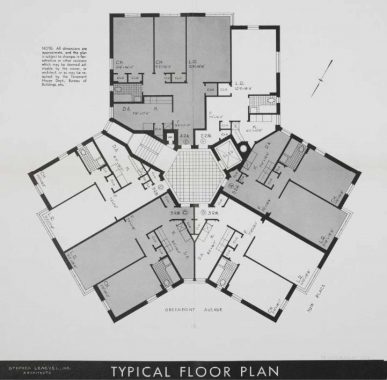
Concerning grid defiance, most of us prefer rooms with 90 degree corners. At 39-40 Greenpoint Avenue, architect Stephen Lengyel accommodated the public with a three-winded building titled Clover Court. To understand the building’s name, here’s its floor plan from the Columbia University collection.

I was disappointed that the hexagonal lobby does not have any art on its floor or walls. Completed in 1941, the building was a latecomer to Art Deco and only the striped brick lines on its exterior relate to this genre. It is more of a precursor to postwar modernism- all brick of the same color without any embellishment.
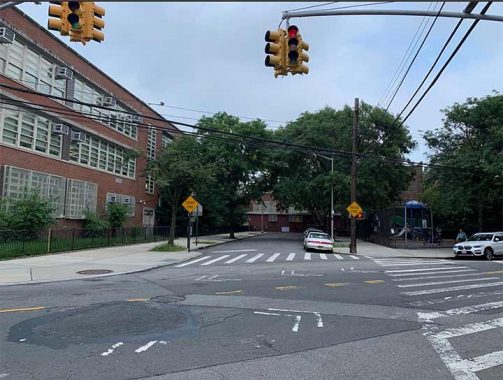
The rectangular blocks appear identical on the map and the street numbers do not skip or repeat with the exception of 39th Place. I do not know why the borough’s Topographical Bureau assigned 39 twice for Sunnyside. At Greenpoint Avenue, this street is interrupted by P.S. 199, which is named for Borough President Maurice Fitzgerald, whose name also appears on the Queens College gymnasium. The school was completed in 1968, breaking up a block to accommodate a growing student body.
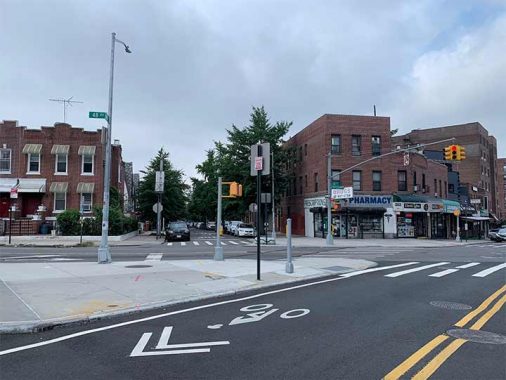
The DOT hates angled intersections and wherever possible, it tries to straighten bowties into crosses in an effort to calm traffic and make streets safer for pedestrians. That’s what the city did with the crossroads of 48th Avenue, Greenpoint Avenue, and 41st Street. Your old Hagstrom map is of little help with so many DOT interventions since the turn of the millennium. You cannot proceed straight by car on 41st Street.
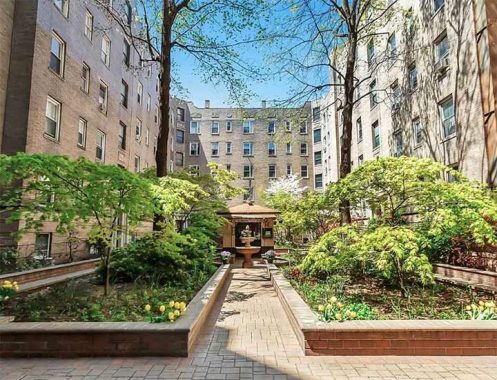
The fanciest of the prewar apartment buildings is likely 45-08 40th Street, which has an interior green space enveloped by the building in the manner of the Dakota, Belnord and other famous Manhattan co-ops. It is across the street from the 40th Street-Lowery station on the elevated 7 train.
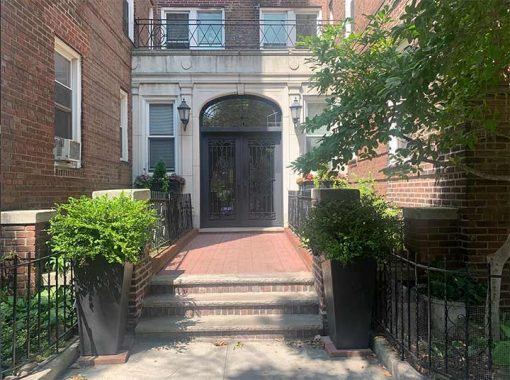
Returning to the north side of Queens Boulevard on my way back to Major World, I stopped by 41-08 43rd Street, where the stone arch entrance contrasts with the simple brick exterior, seemingly a building inside a larger building. Plants along the entrance walkway provide a touch of nature in this densely-built neighborhood.
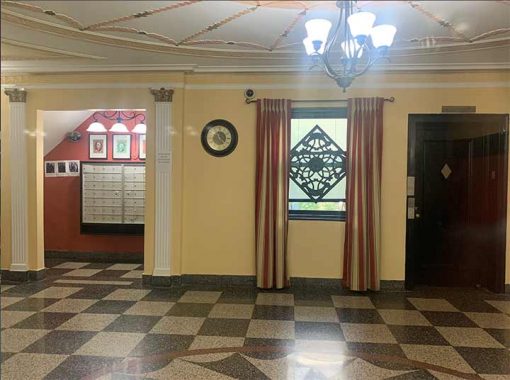
In a city where many neighbors know little of each other, minding their own business, the mail room is a place where some interaction takes place. I don’t remember the address of this lobby, but it’s nice to see framed posters of old postage stamps in the mail room, giving this mundane space a sense of history.
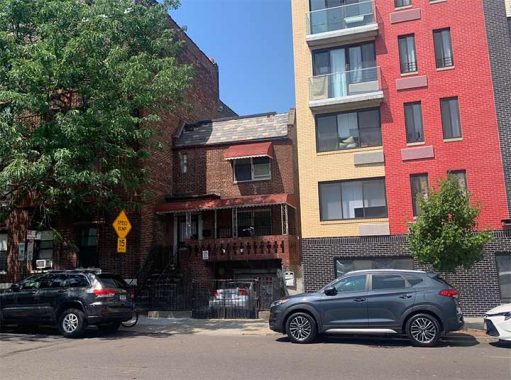
What I like about Sunnyside is its mix of architecture and this includes the two-story holdouts of single and two-family homes. The zoning here is R-7A, and this little home can easily be knocked down in favor of an infill apartment tower. That’s what happened text door, where in 2009, two attached single-family homes and the lot next to them were sold and developed into an eight-story tower.
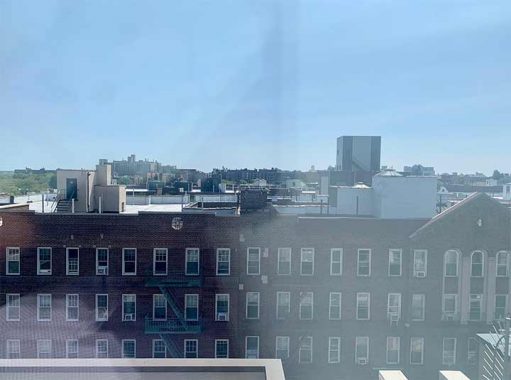
I visited a similar post-millennial tower on 44th Street, but sneaking to the rooftop did not feel rewarding as there wasn’t much to see with nearly all buildings here being the same height.
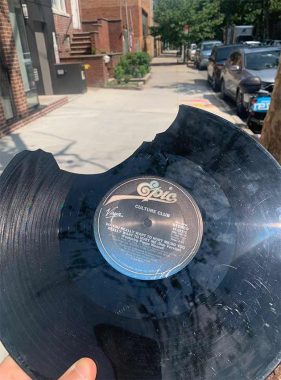
On the street I found a damaged record disc with a song title that matches its condition. Concerning used items, Sunnyside has a sizable free book exchange at Torsney Park. On another visit to Major World, instead of staring into my phone, I went to the book exchange and read for a couple of hours while my car was repaired.
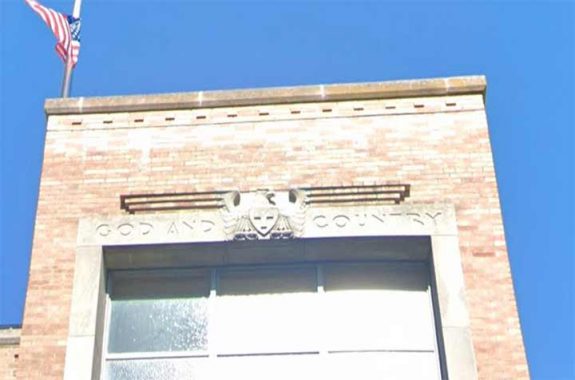
Throughout the city, Catholic schools have been closing for lack of enrollment. Many of them were repurposed as public schools. P.S. 150Q Early Childhood Center is the former Queen of Angels elementary school, which closed in 2004. Atop the building is an American eagle with a crucifix atop a patriotic slogan. We can do an entire essay on Catholic-turned-public schools that retain hints of their religious architecture.
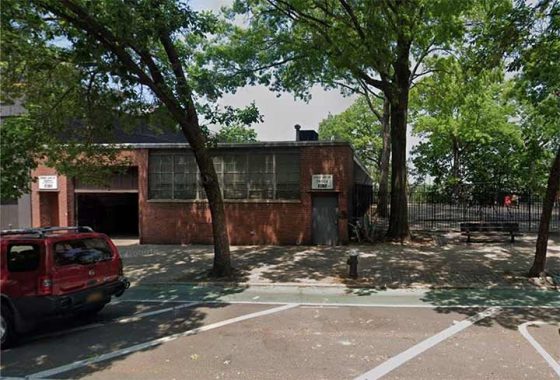
The final doorway in Sunnyside that has a story is a humble garage next to Torsney Park. Herbert Jaffe Inc. was more than a garage. It is an engineering firm founded by a Jewish refugee who fled Nazi Germany in 1938. Unable to enter the United States, he spent the war in Peru where he learned Spanish and engineering in the Andean mines. He later immigrated to New York, graduated from CCNY and had many patents to his name. I met him when he served as president of a synagogue in Forest Hills where I learned to read Hebrew. He died at 96 in late 2022 as one of the last from his generation at Congregation Machane Chodosh, which was founded by German Jewish refugees.
You can learn more about Sunnyside by visiting each of the hyperlinks posted in the essay above. Kevin has been to this neighborhood and its environs many times. Here are a few examples:
Woodside & Sunnyside Walk, 2020
Williamsburg to Sunnyside Part Five, 2017
As always, “comment…as you see fit.” I earn a small payment when you click on any ad on the site. Take a look at the new JOBS link in the red toolbar at the top of the page on the desktop version, as I also get a small payment when you view a job via that link.
9/10/23

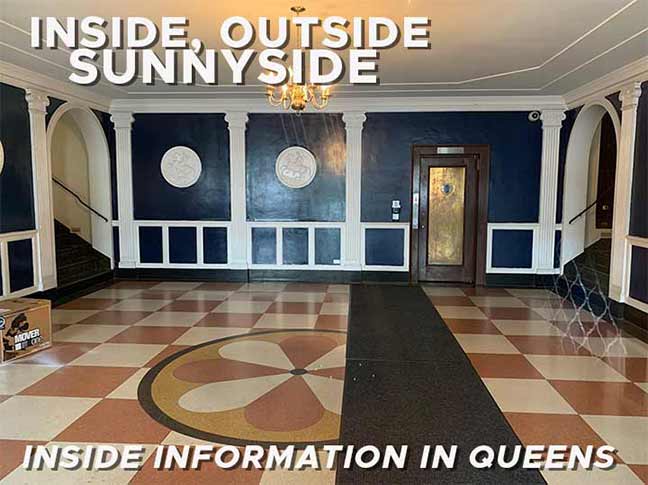
2 comments
Thank you for the nice post on Sunnyside, with the link to the other past Sunnyside stories. It was also nice to see Queen of Angels church, it brought back many memories. Here is some trivia, before the current church was built, the church was across the street in what is now the Parish Center. That building was originally a storefront. Also, when they were numbering the street grid in Sunnyside, it is almost like someone lost count. There are two streets numbered 39! Both 39th Place and 39th Street. What’s up with that?
For 9 years I lived in a building on 39th St, between 50th Ave and the LIE. I can’t tell you how many times visitors or delivery people would get lost and call to tell me they couldn’t find my address…because they were
on 39th Place. Also, 39th St is a 2 way street from Northern Blvd to 50th Ave, and is one of the few bridges over the Sunnyside Yard. It becomes Steinway St north of Northern Blvd. At 50th Ave, it becomes 1 way
south for the one block to the LIE, but the street is still wide enough to be 2 way, and was for some time before they changed it so traffic wouldn’t be able to make a right from the LIE service Road (Hunters Point Ave).
Although that didn’t stop plenty of drivers from going the wrong way down the block anyway. When I lived there, there were still a school zone sign facing south from when it was two ways. They could have made a
fortune if they stationed a traffic cop there to catch all the wrong way drivers.